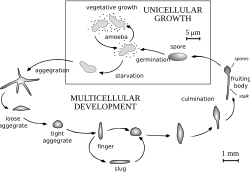35:
130:
77:. The cells flock together, forming a mass that behaves as an organised, slug-like unit. Before they get stimulated to crowd together to form a grex, the amoebae simply wander as independent cells grazing on bacteria and other suitable food items. They continue in that way of life as long as conditions are favourable. When the amoebae are stressed, typically by a shortage of food, they form a grex.
93:
near the tip, and others form structures such as the stalk. Cells forming the structural items, such as the stalk and shell, desiccate and die; only the spores in the fruiting body survive to propagate. When circumstances are right and the fruiting body is mature, its shell ruptures and releases the
84:
that stimulate the flock to vertically assemble in a column. When the column of aggregated cells becomes too high and narrow to stay upright, it topples and becomes a slug-shaped mass: the grex. The grex is mobile; in its form as a slug-like unit it can glide over a moist surface. Once it has moved
94:
spores. The spores then may be transported by media such as wind or water; they then may cover distances far greater than any that they could have achieved in their amoeboid form, and over regions where amoebae could not travel at all, such as dry surfaces.
80:
According to species and circumstances, details of the shape of the grex and how it may form will vary but typically the stressed amoebae first produce
171:
164:
200:
86:
157:
89:
according to their positions in the grex; some become the spore cells and the covering shell of the
28:
195:
190:
141:
184:
103:
66:
62:
39:
34:
129:
17:
137:
81:
58:
85:
far enough to complete its development, the cells of the amoebae
145:
165:
8:
114:Zimmer, C. 1998. "The slime alternative."
172:
158:
31:, used to describe interbreeding orchids.
33:
57:) starts as a crowd of single-celled
7:
126:
124:
25:
128:
1:
144:. You can help Knowledge by
217:
123:
26:
27:Not to be confused with
140:-related article is a
73:is the Latin word for
42:
37:
29:Grex (horticulture)
43:
153:
152:
118:, 19(9), 86-93.
16:(Redirected from
208:
174:
167:
160:
132:
125:
51:pseudoplasmodium
21:
18:Pseudoplasmodium
216:
215:
211:
210:
209:
207:
206:
205:
201:Amoebozoa stubs
181:
180:
179:
178:
121:
112:
100:
49:(also called a
32:
23:
22:
15:
12:
11:
5:
214:
212:
204:
203:
198:
193:
183:
182:
177:
176:
169:
162:
154:
151:
150:
133:
111:
108:
107:
106:
99:
96:
67:Dictyosteliida
61:of the groups
38:Life cycle of
24:
14:
13:
10:
9:
6:
4:
3:
2:
213:
202:
199:
197:
194:
192:
189:
188:
186:
175:
170:
168:
163:
161:
156:
155:
149:
147:
143:
139:
134:
131:
127:
122:
119:
117:
109:
105:
104:Dictyosteliid
102:
101:
97:
95:
92:
91:fruiting body
88:
87:differentiate
83:
78:
76:
72:
68:
64:
63:Acrasiomycota
60:
56:
52:
48:
41:
40:Dictyostelium
36:
30:
19:
146:expanding it
135:
120:
115:
113:
90:
79:
74:
70:
54:
50:
46:
44:
185:Categories
116:Discoverer
110:References
82:pheromones
196:Amoeboids
191:Mycetozoa
138:Amoebozoa
98:See also
59:amoebae
136:This
75:flock
53:, or
142:stub
71:grex
55:slug
47:grex
65:or
187::
69:;
45:A
173:e
166:t
159:v
148:.
20:)
Text is available under the Creative Commons Attribution-ShareAlike License. Additional terms may apply.

